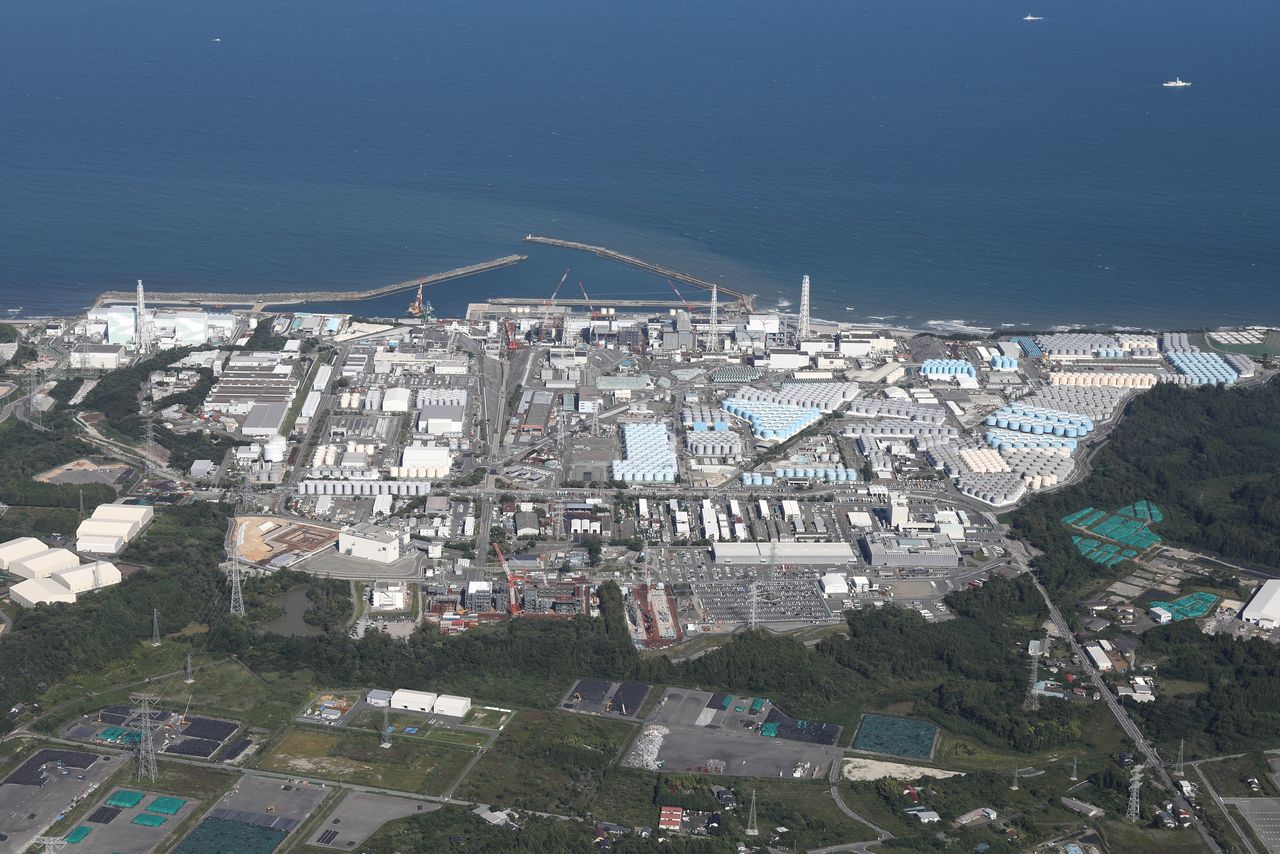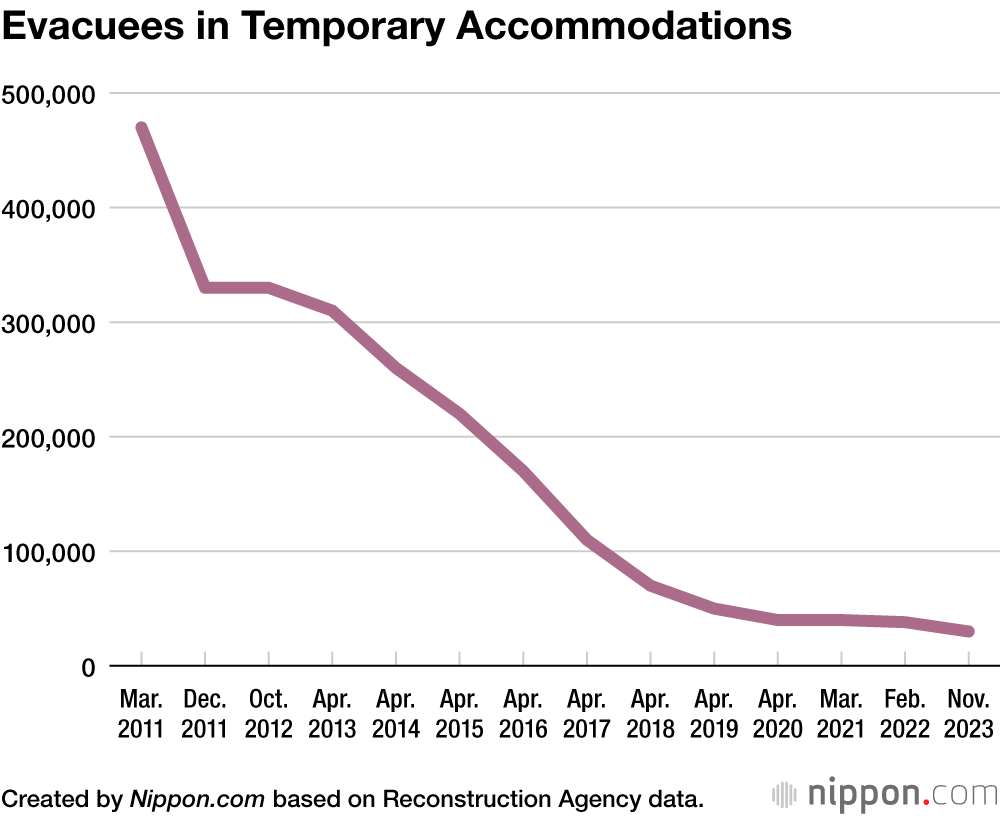
The State of Recovery in Tōhoku 13 Years after 3/11
Society Disaster- English
- 日本語
- 简体字
- 繁體字
- Français
- Español
- العربية
- Русский
Release of Treated Water
In a long-awaited move, Tokyo Electric Power Company on August 24, 2023, began discharging treated water from Fukushima Daiichi Nuclear Power Station. The release includes water used to cool melted fuel debris along with groundwater and rainwater that has seeped into the damaged reactor chamber. The water had been run through adsorption equipment to remove most of the main radioactive elements except for tritium. Around 31,200 tons are scheduled to be released in four discharges by March 2024.
The administration of Prime Minister Suga Yoshihide decided on the controlled release of treated water into the sea in April 2021. Then on July 4, 2023, a report submitted by the International Atomic Energy Agency to Prime Minister Kishida Fumio concluded that the planned release of treated water is consistent with international safety standards.
In June 2023, the Japan Fisheries Cooperatives, expecting repercussion from the release, passed a special resolution strongly urging the government to take full responsibility and deal with any issues that arise. In response to the release, China in August issued a blanket suspension of Japanese seafood imports.

TEPCO’s Fukushima Daiichi Nuclear Power Station, as seen on August 24, 2023. (© Jiji)
New Residence Districts
Decontamination work in communities near Fukushima Daiichi has progressed, although portions of seven municipalities remain closed to habitation.
After ramping up decontamination in “specified reconstruction and revitalization base areas,” special districts inside zones closed to habitation indefinitely, in June 2022 the government began allowing evacuees to return permanently, with restrictions being lifted for all special districts in May 2023. Reconstruction of infrastructure in Ōkuma, Futaba, and other affected towns has progressed, although only a handful of former residents have expressed interest in moving back.
In June 2023, the Diet revised reconstruction and revitalization legislation for Fukushima to allow for the establishment of “specific revitalized residential areas” within zones closed to habitation indefinitely. Under the system, residents wishing to return to their homes can make a request to municipal authorities, who must draw up a plan and submit it to the national government to receive funds for decontamination of roads and other areas around homes. Several requests in Ōkuma, Futaba, Namie, and Tomioka have been approved and decontamination work started.
Legal Cases and Other Developments
Courts continued to pass down rulings in some 30 class-action suits that have been filed over the meltdown at the Fukushima Daiichi plant. On February 14 of this year, the Sendai High Court ordered TEPCO to pay just over ¥1 billion in damages to 323 residents of Kawamata. The amount was ¥500 million more than what a lower court awarded to 299 plaintiffs in an earlier case. The government in November 2022 moved to expand the scope of compensation for damage linked to the nuclear accident after court rulings ordering TEPCO to pay more in recompense to victims.
In October 2023, TEPCO settled with 84 of the 87 plaintiffs in a case brought by residents of Minamisōma, Futaba, and other municipalities where evacuation orders were put in place. Under the settlement, the first among the class-action suits, the utility agreed to apologize to the plaintiffs and pay compensation. On January 31 of this year, TEPCO also settled in a case brought by evacuees in Niigata Prefecture.
Overview of the Great East Japan Earthquake
The magnitude 9.0 quake struck on March 11, 2011, at 2:46 pm, triggering a devastating triple disaster. The epicenter was off Tōhoku’s Sanriku coast. Strong tremors were felt across a wide area, registering 7 on the Japanese seismic intensity scale in Kurihara in norther Miyagi Prefecture and lower to upper 6 in areas spanning eight prefectures. The massive tsunami triggered by the quake slammed into communities along Japan’s northeast Pacific coast, topping 9.3 meters in Sōma in Fukushima Prefecture, 8.6 meters in Ishinomaki in Miyagi, and 8.5 meters in Miyako in Iwate Prefecture. It also touched off a triple meltdown at the Fukushima Daiichi Nuclear Power Station. On June 20, three months after the disaster, the government estimated that 15,000 people had died, 7,500 were missing, and 5,440 had been injured. About 470,000 people were forced to evacuate in the first few days, with the number of temporary housing units eventually reaching some 124,000.
According to Reconstruction Agency data, the death count from the catastrophe stands at 19,765, including disaster-related fatalities from suicide and illness, with 2,553 individuals still unaccounted for. Over 120,000 homes were also destroyed. As of February 2024, almost 30,000 people remain in temporary accommodations.
(Originally published in Japanese. Banner photo: People attend an event in Futaba, Fukushima Prefecture, held by a support organization, welcoming residents back to the town on August 26, 2023. © Jiji.)

